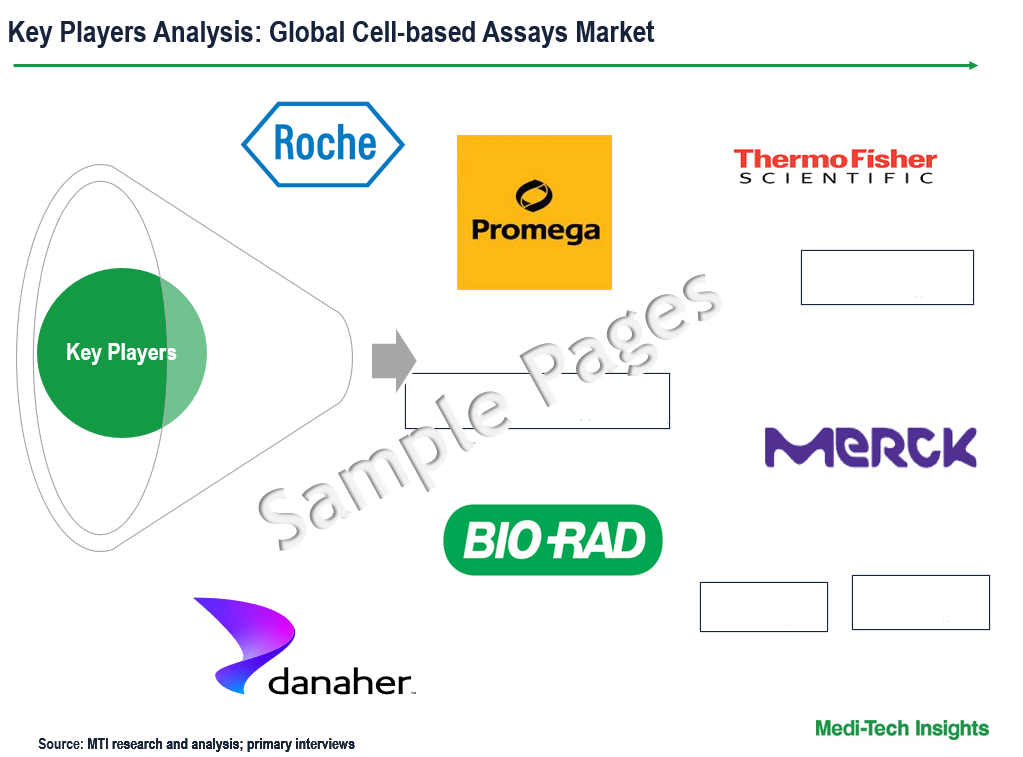A number of variables are coming together to support this development trajectory, including rising demand brought on by growing applications in various biological research and healthcare domains. Higher-throughput screening, real-time monitoring, and multi-parametric analysis with improved accuracy and efficiency are made possible by technological advancements in assay procedures, imaging methods, and automation. To learn more about the research report, download a sample report.
The cell-based assays market is expected to rapidly increase between 2024 and 2029. The market is expected to develop at a strong 8-10% annual rate, driven by a variety of factors driving innovation, accessibility, and efficacy in cell-based diagnostics and research.
Cell-based assays, which are used to elucidate biological processes and medication reactions in vitro, are in high demand across a variety of industries, including life sciences and healthcare. From drug discovery and development to disease research and toxicity, these tests have become vital tools for both researchers and physicians.
Key Market Drivers
Technological Advancements
Continuous innovations in assay methodologies, imaging techniques, and automation have revolutionized the field, enabling high-throughput screening, real-time monitoring, and multi-parametric analysis with unprecedented precision and efficiency.
Expanding Applications
The versatility of cell-based assays transcends traditional boundaries, finding applications in oncology, neuroscience, immunology, stem cell research, and regenerative medicine, among others. Their ability to mimic complex physiological environments and disease states positions them as indispensable assets in modern research and diagnostics.
Rising Demand for Personalized Medicine
With a paradigm shift towards personalized therapeutics, cell-based assays offer invaluable insights into patient-specific responses to drugs and treatments, facilitating tailored interventions and optimizing clinical outcomes.
Increasing Focus on Drug Safety and Toxicity Screening
Heightened regulatory scrutiny and the imperative for safer pharmaceuticals have propelled the demand for cell-based assays in toxicity testing and safety pharmacology, enabling early identification of adverse effects and minimizing risks in drug development pipelines.
To learn more about this report, download the PDF brochure
Key Constraints/Challenges
Complexity and variability
Cell-based assays can be complex and inherently variable due to differences in cell lines, culture conditions, and experimental protocols. Ensuring reproducibility and standardization across assays poses significant challenges, impacting data reliability and comparability.
Cost and resources
Cell-based assays often require specialized equipment, reagents, and skilled personnel, making them costly and resource-intensive. High upfront investment and ongoing operational expenses can limit adoption, particularly for smaller research laboratories or resource-limited settings.
Time-consuming Processes
Cell-based assays typically involve lengthy culture periods, multi-step protocols, and time-consuming data analysis, leading to prolonged turnaround times. This can hinder efficiency and scalability, especially in high-throughput screening applications or urgent clinical diagnostics.
Market Segmentation by Region for Cell-based Assays
Growing R&D expenditures, technology developments, a supportive healthcare system, a supportive regulatory environment, cooperative research projects, the rising incidence of chronic illnesses, and the expanding use of personalized medicine all support the market’s strong growth in North America. Similar to this, the aging population and the resulting rise in chronic diseases, the focus on personalized medicine, the importance of healthcare sustainability, and the expanding pharmaceutical and biotechnology sectors—which are driving demand for cell-based assays in drug discovery, toxicity screening, etc.—are all contributing factors to the growth of the European market.
The need for cutting-edge medical technology, such as cell-based assays, is being driven by the Asia-Pacific region’s increasing urbanization, growing disposable incomes, and better access to healthcare. The market is developing as a result of the expanding healthcare infrastructure, the burgeoning biopharmaceutical sector, and the rising prevalence of chronic illnesses.
Competitive Landscape
Some of the key players operating in the market include BD, Bio-Rad Laboratories, Inc., Corning Inc., Charles River Laboratories, Danaher Corp., F. Hoffmann-La Roche Ltd., Lonza, Merck KGaA, Promega Corp., and Thermo Fisher Scientific Inc., among others.
Get a Sample Report for Competitive Landscape Analysis
Organic and Inorganic Growth Strategies Adopted by Players to Establish Their Foothold in the Market
Players operating in this market are adopting both organic and inorganic growth strategies such as collaborations, and acquisitions to garner market share. For instance,
- In August 2022, a well-known biotechnology company, LifeNet Health LifeSciences, introduced a platform for cell-based assays. This new service, acquired through the acquisition of IONTOX, provides advanced options for screening substances in laboratory settings instead of using animals for testing. This approach offers more efficient and effective ways to assess the safety and efficacy of products.
- In March 2022, Promega Corporation and FUJIFILM Cellular Dynamics, Inc. formed a collaboration to advance in novel assay development for drug discovery. This collaboration involves the integration of custom differentiated induced pluripotent stem cells (iPSCs) with Promega’s biosensor and intracellular bioluminescent reporter capabilities, enabling researchers to develop innovative assays for drug discovery
